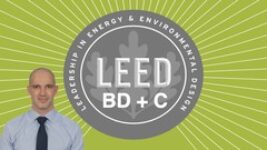
The Subtle Art of “LEED V4 BD+C – Sustainable New Buildings”
Requirements
-
No prerequisites are needed. We will teach you all that is required
Description
About This Class
The importance of sustainability needs little introduction, we can see the impacts of global warming and the increase in CO2 emissions . The built environment contributes almost 40% of annual CO2 emissions, and when well designed they can reduce the stress on the environment and improve human health.
This course is without a doubt one of the most comprehensive LEED V4 BD+C course available online.
You know that there is a lot information, with the reference guide well over 800 pages. Where do you begin? How do I start learning? What information is important? How do I best prepare myself for the exam – especially with so many different responsibilities you have…
Even if you have zero Green building knowledge, this course is right for you and here’s why:
- The course is taught by a LEED AP certified instructor with 15 years of experience in sustainability.
- The course has been updated to be 2023 ready and you’ll be learning the latest LEED v4 material
- The course is short and sweet. Without cutting any corners, no need to watch 20 hours of content to ace the exam.
- The curriculum was developed and is updated based on comprehensive student testing and feedback.
- Includes 200 real life exam questions to prepare yourself in 2 mock exams.
- I have taught over 500 students how to pass the LEED Exams and with a 100% pass rate guarantee or have your money back!
This is the complete guide. I am so confident that you will love this course that we are offering a FULL money-back guarantee for 30 days! so it’s a complete no brainer, sign up today with ZERO risk and EVERYTHING gain.
So what are you waiting for? Click the buy now button and join the fastest and easiest way to pass the LEED AP Exam!
What will you learn?
The key concepts and tools for LEED BD&C. Around 90 specific lessons ranging from 2 to 7 minutes on all important credits. Here a handful of examples.
-
- Indoor Environmental Quality (IEQ): This includes concepts such as indoor air quality, thermal comfort, lighting, and acoustics, which are intended to promote the health and well-being of building occupants.
- Energy Efficiency: This includes concepts such as energy modeling, lighting power density, and commissioning, which are intended to reduce energy consumption and greenhouse gas emissions.
- Materials and Resources: This includes concepts such as recycled content, regional materials, and low-emitting materials, which are intended to reduce the environmental impact of building materials and products.
- Water Efficiency: This includes concepts such as water-efficient fixtures, greywater systems, and landscape irrigation, which are intended to reduce water consumption and protect water resources.
- Sustainability: This includes concepts such as sustainable sites, transportation, and urban design, which are intended to promote sustainable land use and community development.
- Innovation: This includes concepts such as innovation in design, and innovation in operations, which are intended to recognize exceptional performance in areas not specifically addressed by other LEED credits.
- Regional Priority: This includes concepts that address environmental issues that are specific to a particular region, such as heat island reduction and stormwater management.
Why take this course?
- You will be prepared for the LEED BD+C Accredited professional Exam.
- You will be able to speak about LEED and sustainability with confidence.
- You will understand the difference terms, definitions and requirements.
- You will learn from an experienced sustainability consultant and educator
- It’s short, effective and practical. Think of this course as exam preparation together with tips and focus points.
- It’s been developed from the ground up with a focus on quality.
Who this course is for:
- Architects and designers who are involved in the design and construction of new buildings and renovations, and who are seeking to understand how to design and construct buildings that are sustainable and meet the requirements of the LEED V4 BD+C rating system.




